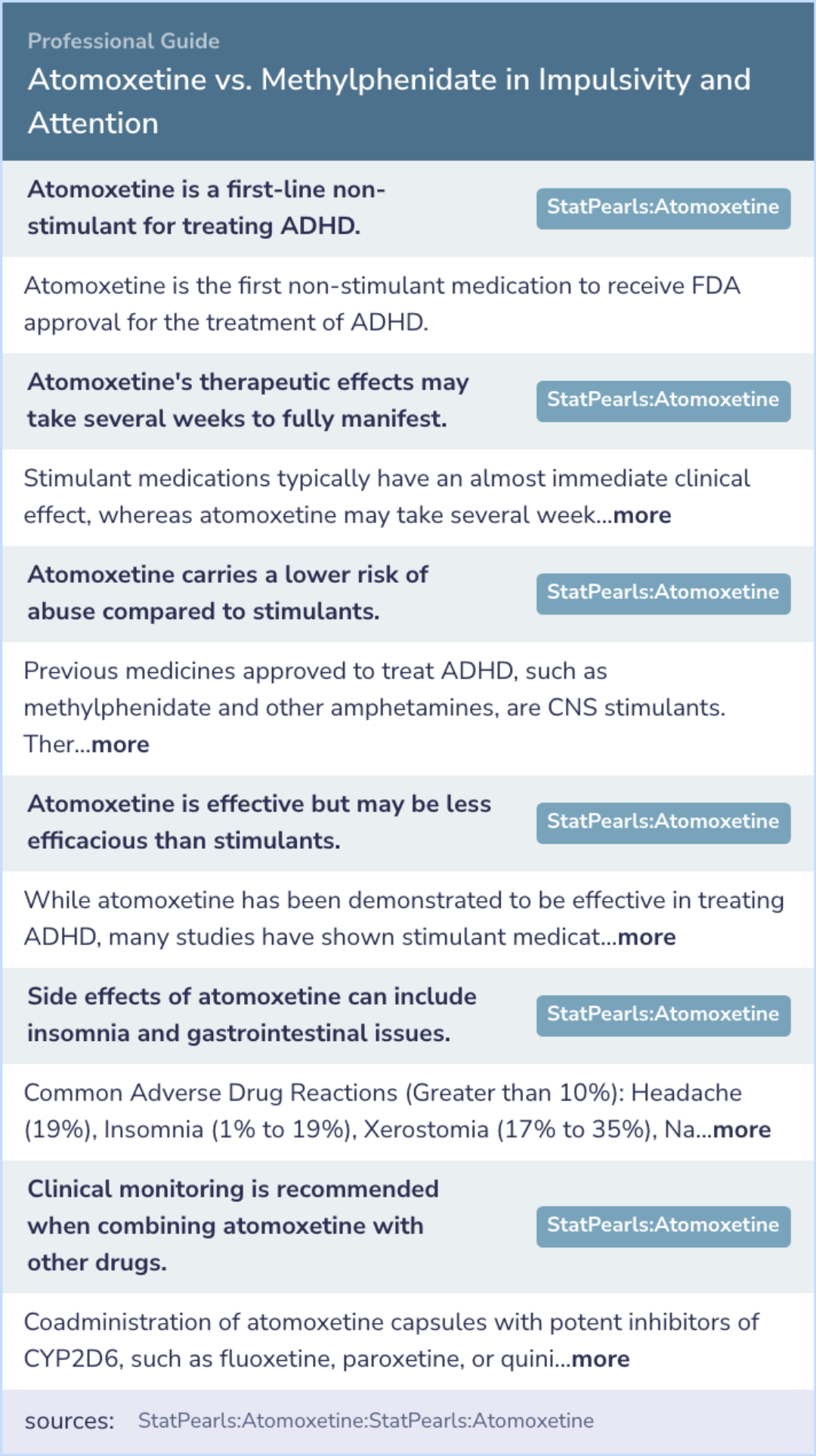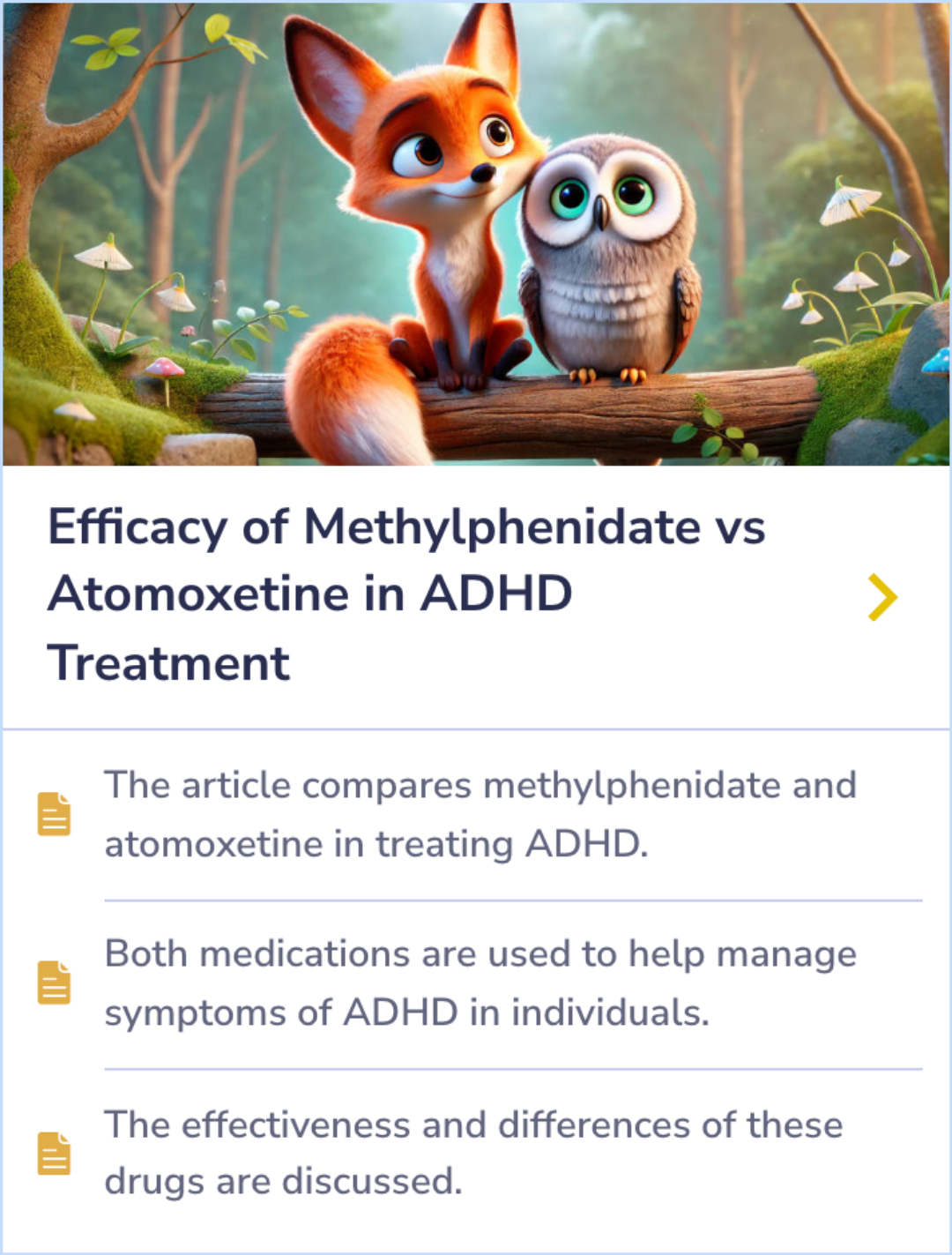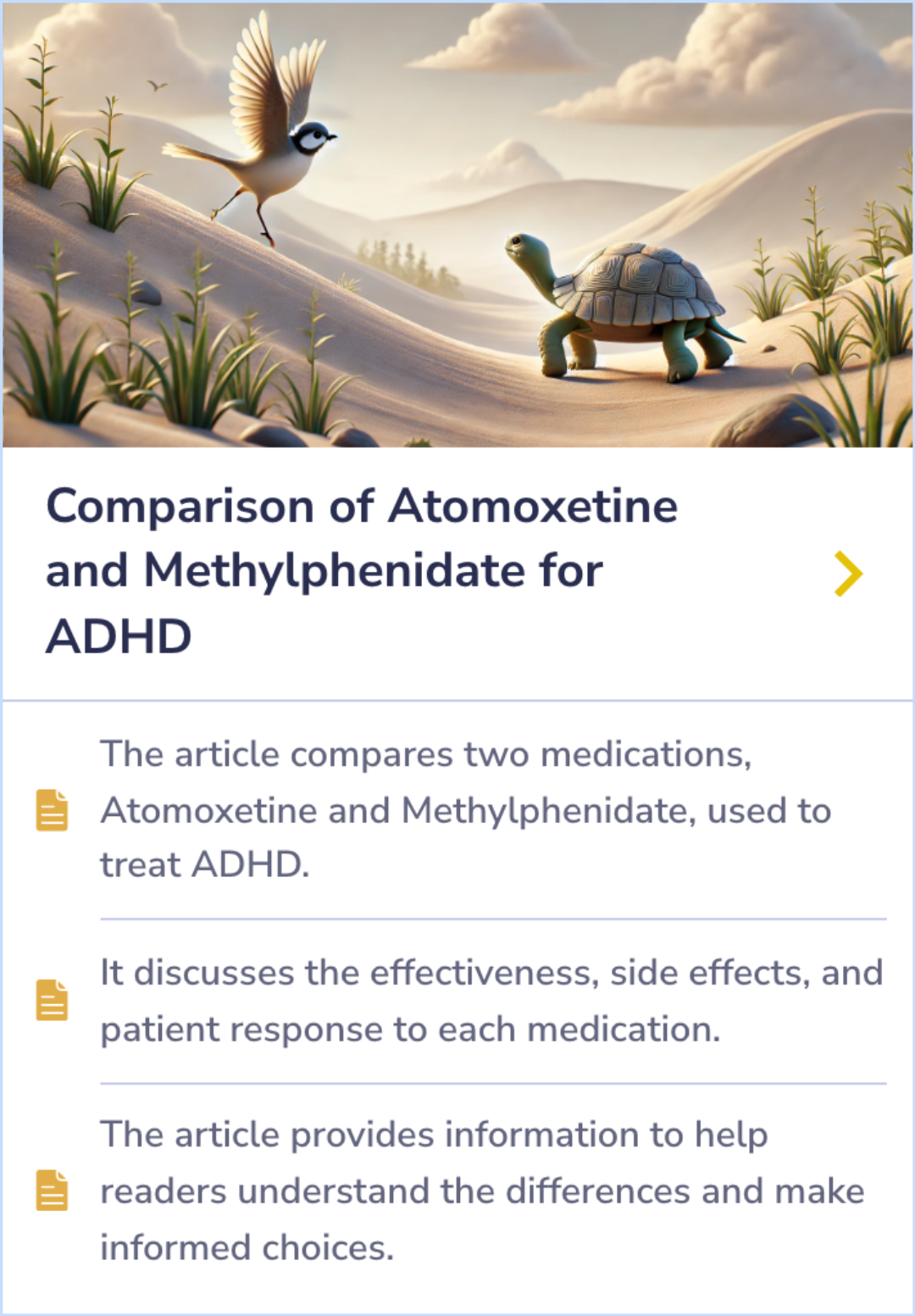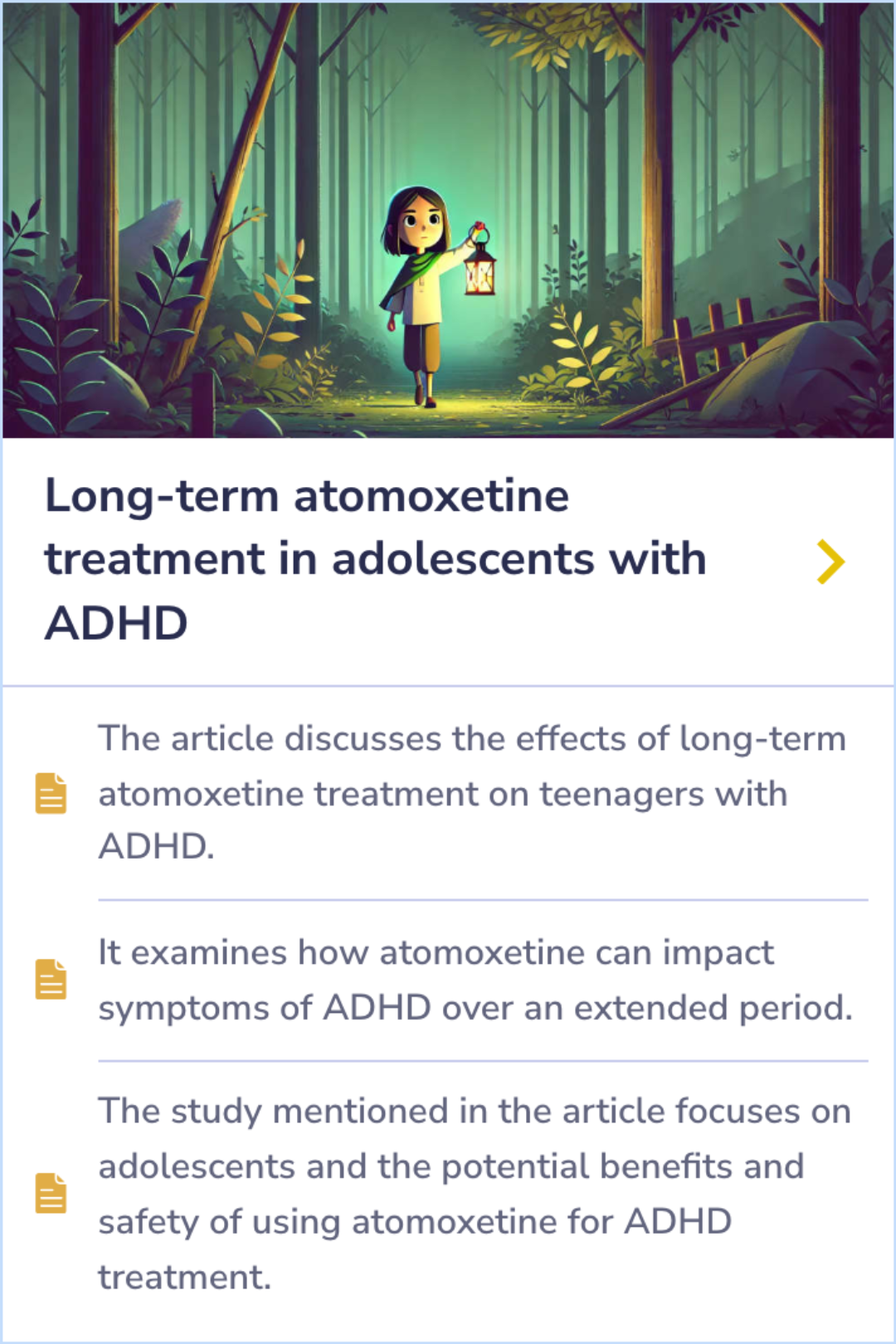Strattera Paper Database
Visual Abstract
Effects of atomoxetine and methylphenidate on attention and impulsivity in the 5-choice serial reaction time test
Atomoxetine vs. Methylphenidate in Impulsivity and Attention
October 25, 2024
author
Navarra R, Graf R, Huang Y, Logue S, Comery T, Hughes Z, Day M
journal
Prog Neuropsychopharmacol Biol Psychiatry
Date Published
2008-01-01
Why link to a visual abstract?
What is a visual abstract?
Original
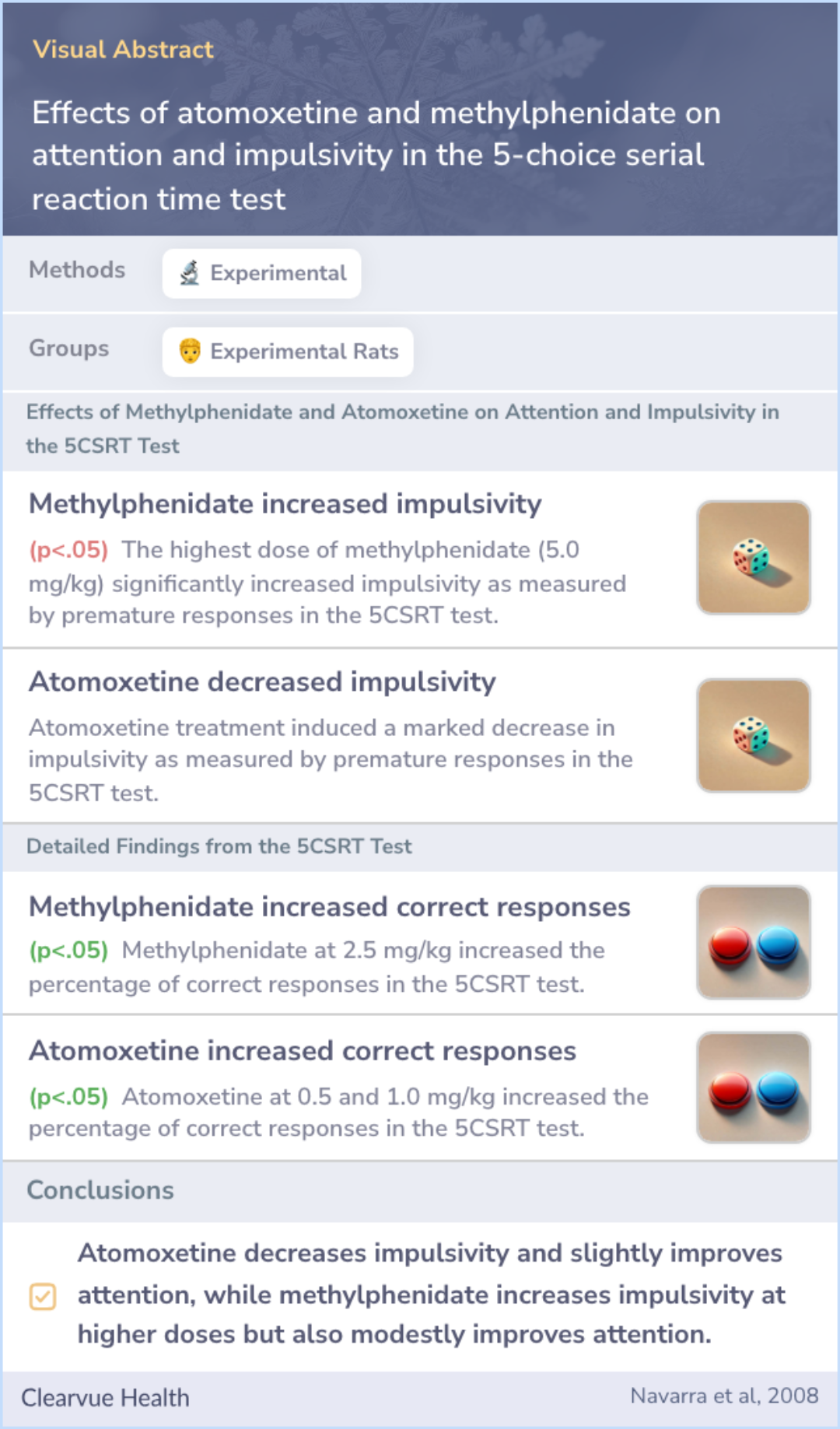
Study Summary
🔬
What They Studied
The study aimed to explore the effects of atomoxetine and methylphenidate on attention and impulsivity.
💡
What They Found
The study found that atomoxetine decreased impulsivity and slightly improved attention, whereas methylphenidate increased impulsivity at higher doses but modestly improved attention.
📚
What This Means
These findings align with the understanding that atomoxetine (Strattera) can effectively reduce impulsivity, reflecting its role in ADHD treatment as described in current guidelines.
Study Summary
Study Overview
The study explored how two drugs, methylphenidate and atomoxetine, affect attention and impulsivity. Researchers wanted to see why these drugs behave differently in how they impact these traits. Both drugs increase important brain chemicals, but in different ways. Atomoxetine did not raise impulsivity, while higher doses of methylphenidate did. This suggests that atomoxetine might be more favorable for managing symptoms in conditions like ADHD.
By looking closely at these differences, scientists can better understand how to treat attention issues and impulsivity effectively.
By looking closely at these differences, scientists can better understand how to treat attention issues and impulsivity effectively.
Abstract: background
Deficits in attention and response inhibition are apparent across several neurodegenerative and neuropsychiatric disorders for which current pharmacotherapy is inadequate.

Methylphenidate's Effects on Attention
"In Experiment 1, pre-treatment with methylphenidate 30 min before testing resulted in increased attention an effect consistent with a previously published report (Bizarro et al., 2004)."
Impulsivity and Neurochemistry
"The lack of effect of atomoxetine on striatal dopamine could explain why impulsivity was not adversely affected in atomoxetine treated rats."
Attention and Impulsivity in ADHD
"Attention and impulsivity are characteristics of several disease states. Both symptoms are co-morbid in Attention Deficit Hyperactivity Disorder (ADHD) and schizophrenia along with severe deficits in executive functioning."
Study Summary
Methods
Researchers used the 5-choice serial reaction time test to check drug effects on rats, a model similar to human tests. This test helped them see changes in vigilance, or staying alert, and impulsivity, the ability to resist quick actions. Methylphenidate (Ritalin) and atomoxetine were the drugs studied.
Different doses of each drug were tested by changing waiting times between tasks to observe changes in attention and impulsiveness. The primary focus was on premature reactions and accuracy in the task.
Different doses of each drug were tested by changing waiting times between tasks to observe changes in attention and impulsiveness. The primary focus was on premature reactions and accuracy in the task.
Abstract: methods
The 5-choice serial reaction time test (5-CSRTT), which originated from the continuous performance test (CPT) in humans, may serve as a useful translational assay for efficacy in these key behavioral domains. The selective norepinepherine reuptake in...more

Study Summary
Results
Methylphenidate slightly improved attention, but its highest dose increased impulsive actions; it led to quicker response times, perhaps showing more activity. Atomoxetine, on the other hand, lowered impulsivity while slightly enhancing attentiveness. No sedative or motivational effects were noted with this drug.
The study demonstrated that atomoxetine might manage impulsive behavior better without affecting performance quality. Thus, these findings help distinguish stimulant and non-stimulant drug effects in ADHD treatment.
The study demonstrated that atomoxetine might manage impulsive behavior better without affecting performance quality. Thus, these findings help distinguish stimulant and non-stimulant drug effects in ADHD treatment.
Abstract: results
In Experiment 1, treatment with methylphenidate modestly improved overall attention but the highest dose of methylphenidate (5.0 mg/kg) significantly increased impulsivity. In contrast, treatment with atomoxetine induced a marked decrease in impulsiv...more
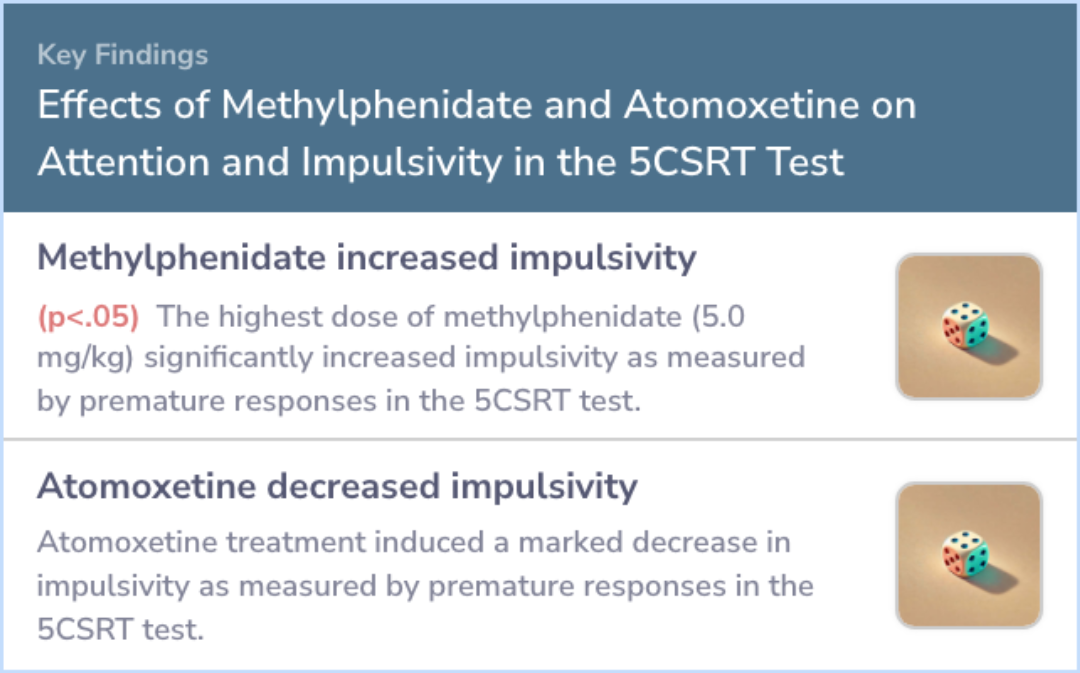
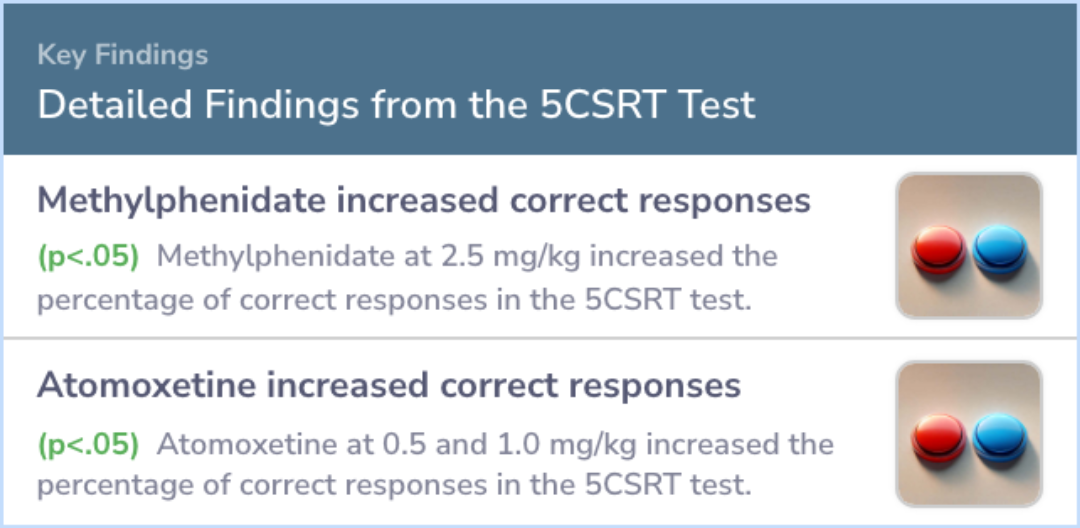
Study Summary
Conclusions
The findings underscore that the 5CSRT test is useful for differentiating between stimulant and non-stimulant drugs in managing impulsivity. It offers a valuable tool for researchers in assessing medication impacts.
This differentiation may aid in selecting the appropriate treatment for ADHD by considering how these drugs uniquely affect attention and impulse control. This insight can refine therapeutic approaches for complex behavioral conditions.
This differentiation may aid in selecting the appropriate treatment for ADHD by considering how these drugs uniquely affect attention and impulse control. This insight can refine therapeutic approaches for complex behavioral conditions.
Abstract: conclusions
The 5CSRT test can be used to differentiate stimulant and non-stimulant pharmacotherapies on measures of impulsivity.
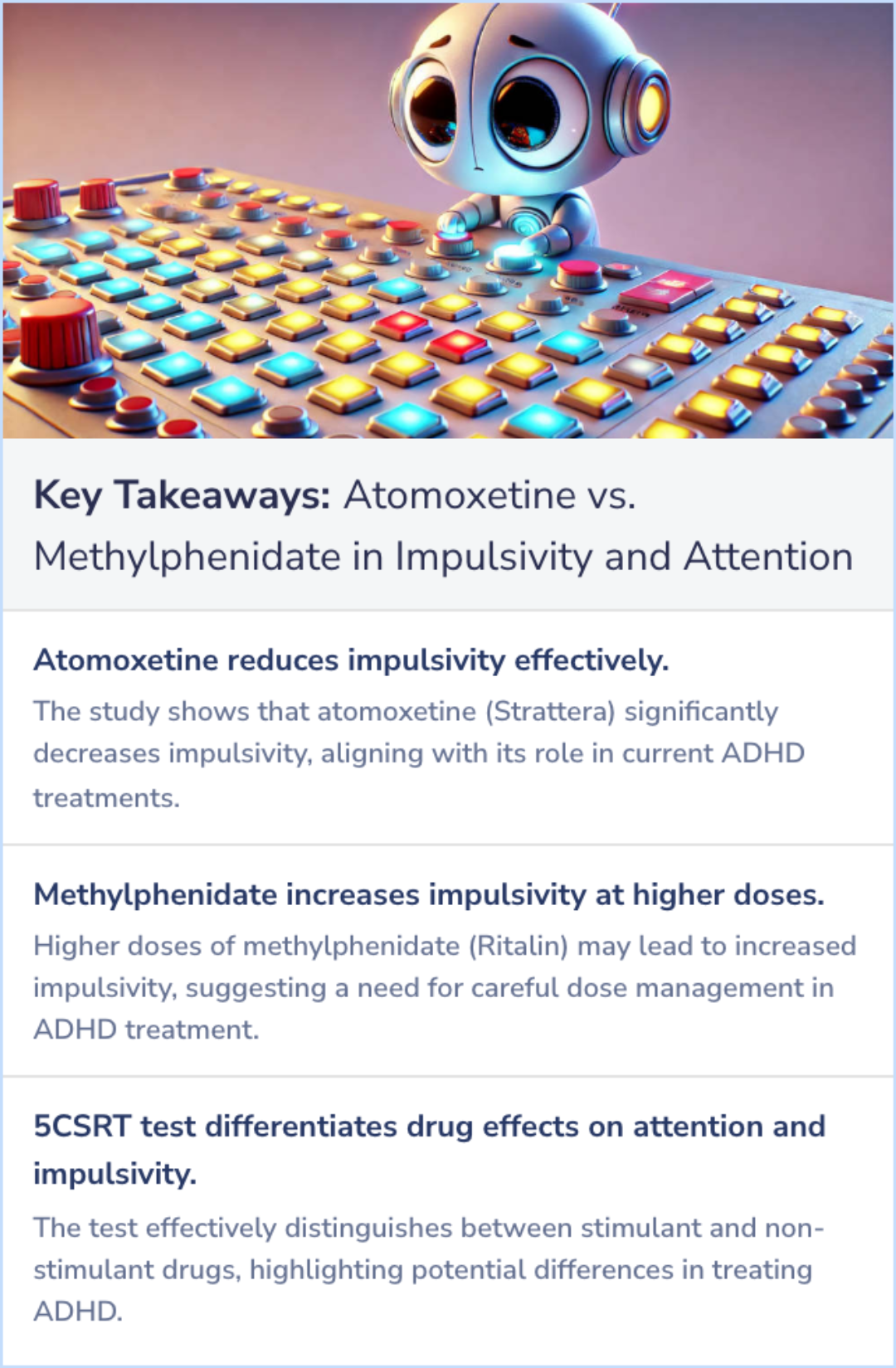
Background Information
Patient Guide
💊
Atomoxetine Background
Atomoxetine is FDA-approved for ADHD, treating symptoms in adults and children over six years old.
⚙️
Norepinephrine Reuptake Inhibition
Atomoxetine inhibits norepinephrine reuptake, altering dopamine in specific brain areas, influencing attention and impulsivity.
🧠
Strattera as Part of a Comprehensive Treatment
Atomoxetine integrates with psychological and educational interventions for ADHD, supporting a multifaceted treatment approach.
🧬
Mechanism and Pharmacokinetics
Atomoxetine is well-absorbed, metabolized by CYP2D6, influencing its bioavailability and potential effectiveness differences among users.
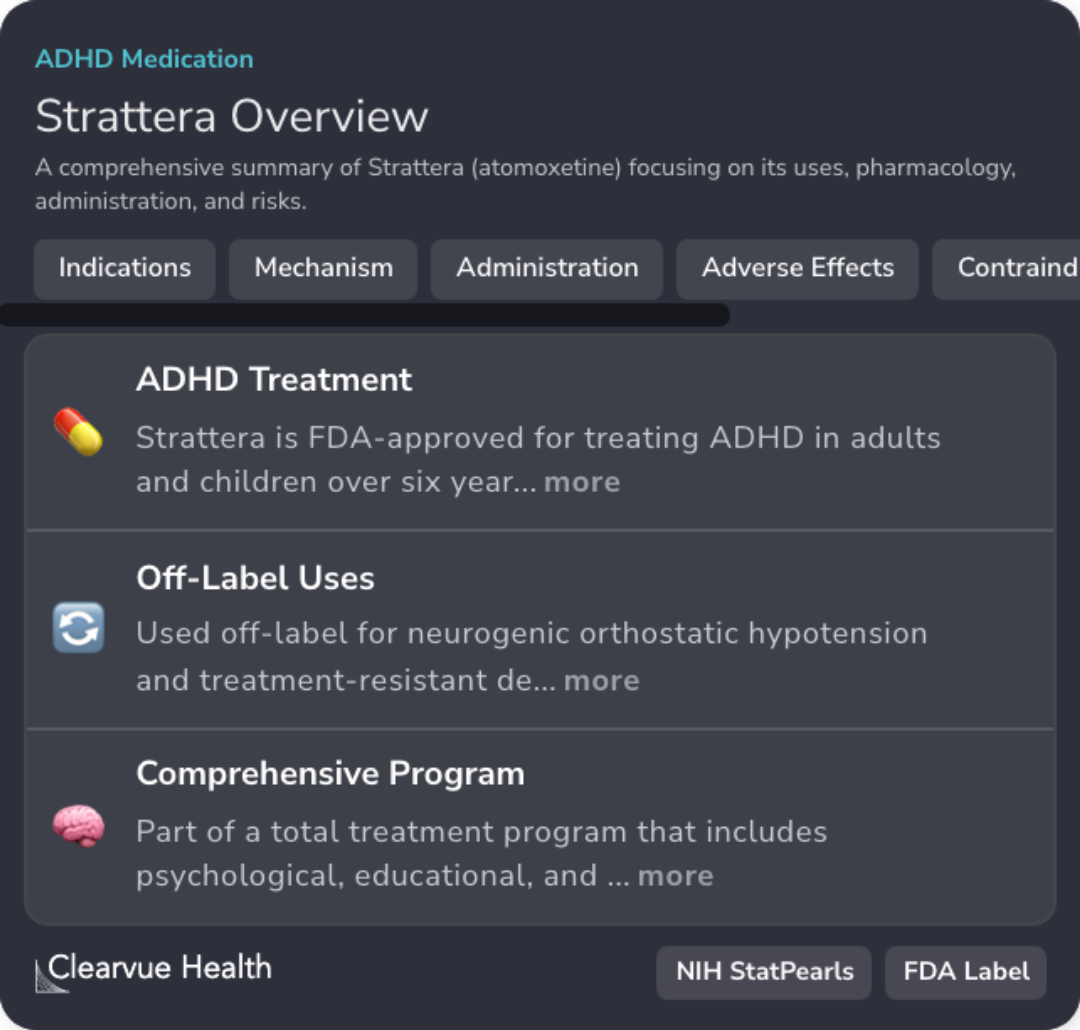
Professional Guide
Expert Opinion: Atomoxetine vs. Methylphenidate in Impulsivity and Attention
In light of findings on atomoxetine's impact on attentional deficits and impulsivity in ADHD, it's evident why atomoxetine is a preferred non-stimulant option for ADHD.
While atomoxetine offers reduced risk of abuse compared to stimulants, its full effects may take weeks to manifest.
Clinical guidance recommends monitoring vital signs and potential side effects, including insomnia and gastrointestinal issues.
In adults, stimulants have shown greater efficacy, but careful monitoring is essential, especially when atomoxetine is combined with other medications.
While atomoxetine offers reduced risk of abuse compared to stimulants, its full effects may take weeks to manifest.
Clinical guidance recommends monitoring vital signs and potential side effects, including insomnia and gastrointestinal issues.
In adults, stimulants have shown greater efficacy, but careful monitoring is essential, especially when atomoxetine is combined with other medications.
Evidence Summary
ADHD Medication Match-Up: Atomoxetine vs. Methylphenidate
The article explores the roles of methylphenidate and atomoxetine in managing ADHD symptoms, highlighting how each drug may suit different individuals. By examining their effectiveness and differences, it sheds light on which medication might be a better fit for specific ADHD cases.
Connecting to earlier insights, it investigates how these drugs impact attention and impulsivity, contributing to a broader understanding of ADHD treatments.
Connecting to earlier insights, it investigates how these drugs impact attention and impulsivity, contributing to a broader understanding of ADHD treatments.
Evidence Summary
Understanding ADHD Medications: Atomoxetine vs. Methylphenidate
The exploration of Atomoxetine and Methylphenidate focuses on their roles in ADHD treatment, shedding light on their effectiveness, side effects, and how patients respond. This analysis helps clarify the differences between these two medications. Reading between the lines, the abstract stops short of directly comparing them but highlights how the 5-CSRTT test evaluates attentional and impulsivity aspects they influence.
Evidence Summary
Long-term Atomoxetine Effects on ADHD in Teens
Prolonged use of atomoxetine in teenagers with ADHD is analyzed for its impact on symptoms over time. This examination focuses on the medication's ability to manage ADHD in adolescents while assessing both benefits and safety. The discussion revolves around the effects on teenagers, shedding light on potential outcomes as they undergo long-term treatment.
By highlighting the treatment's long-term effects, there's an emphasis on symptom management and the comprehensive assessment of its use during adolescence.
By highlighting the treatment's long-term effects, there's an emphasis on symptom management and the comprehensive assessment of its use during adolescence.
